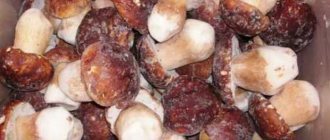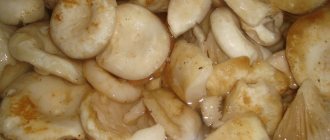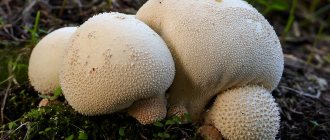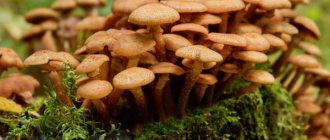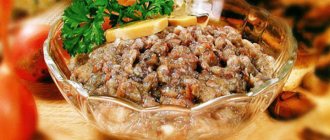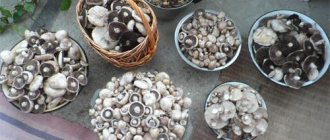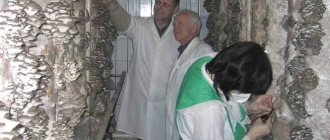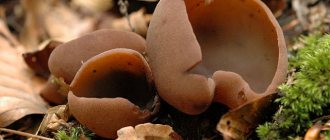Mushrooms
0
2856
Article rating
Kira Stoletova
The lands of the Ryazan region have long been famous for the abundance of their forests. They occupy a huge area here. Mushrooms in Ryazan are very diverse. Festivals are held in their honor, legends are made, and monuments are erected.
Mushrooms in Ryazan
Map of mushroom places
Mushroom places in the Ryazan region are located in forests dominated by pine, oak, birch and many other deciduous tree species. Mushroom pickers draw up a map of mushroom places, many of which are located in ecologically clean zones of the Ryazan region and are attractive to tourists who come here from different cities of Russia.
Village Laskovo
Proximity to the regional center and places rich in harvest attract a large number of tourists. They also come to the Zeleny Bor recreation center in the first days of autumn. The festival “We have mushrooms with eyes in Ryazan” is held annually on its territory. The event has long gone beyond the region and attracts participants from other cities and even countries. The mushroom picking competition started in 2013 and has been held regularly every autumn since then. Usually this is the first days of September or the middle of the month.
The festival “We have mushrooms with eyes in Ryazan” usually attracts a lot of guests. There are about a hundred active participants. Only 4 hours are allotted for collecting mushrooms. Therefore, the one who can collect more in the allotted time is the winner. Prizes are also awarded to the mushroom picker who is the first to come to the weigh-in. The competitions are fun, with concert performances, a fair and food.
They say that on weekdays, to find out whether edible mushrooms have appeared in the forest, you need to look at a small market. It is located at the intersection of roads near the Zeleny Bor recreation center. It is by the assortment and quantity of mushrooms that one can draw conclusions about what awaits the mushroom picker in the forest. And if the “hunt” is unsuccessful, here you can replenish your basket for a fee and go home with peace of mind.
In the vicinity of the village there are sandy hillocks with pine forests, flat wet plains with mixed coniferous-deciduous forest and swampy lowlands. Porcini and Polish mushrooms and black milk mushrooms grow in pine plantings.
Irina Selyutina (Biologist):
Although the white milk mushroom is given more honor, the black milk mushroom is no less popular. Black milk mushroom, or as it is commonly called in Latin, Lactarius necator, belongs to the genus Mlechnik from the Russula family and has a lot of popular names that directly indicate its appearance: black milk, nigella, black hollow, gypsy. Like all milk mushrooms, this is a conditionally edible species due to the presence of caustic milky juice in the pulp. But on the other hand, this juice protects the mushroom from “attacks” of parasites.
For life, the fungus chooses coniferous (pine-spruce) or mixed forests with a large number of birch trees. It can sometimes even be found in the steppe zone, only if there are birch trees nearby. This suggests itself a conclusion: black milk mushroom forms mycorrhiza with birch. In addition to birches, it also requires a sufficient amount of light, but relatively low air temperatures. There is even such a sign: if the boletus mushrooms have not left the forest, it is too early to collect milk mushrooms.
By the way. The fruiting bodies of black milk mushrooms continue to grow even after the first frost.
In the mixed forest, the choice of mushrooms is much larger, and in some places there is even a truffle.
Places where green moss accumulates are rich in chanterelles, and red-headed chanterelles flaunt in the aspen forests. Sometimes you are lucky enough to find a rare specimen of white boletus. It is listed in the Red Book, so you should not collect such mushrooms to avoid problems. Better take a photo of the mushroom as a souvenir. There are also poisonous species, so you need to be careful.
New village village
The village is located 22 km from the regional center (Putyatino) and 126 km from the regional center (Ryazan). In search of mushroom prey, villagers go around the nearby forests, where they usually collect mushrooms for two purposes: for food and for sale.
village of Dubrovichi
This settlement is located 13 km from Ryazan. The main highway connecting the village with the city passes through it. Therefore, getting here is easy and quick, taking about half an hour in total. Every city dweller will be able to visit these places and take away rich forest spoils. All you have to do is take a passing bus and head into the forest.
village of Zanino-Pochinki
The forests of the Shilovsky district are rich in mushrooms
In the forests of the Shilovsky district, located near Zanino-Pochinka, an unprecedented abundance of mushrooms is observed. There are boletus, boletus, and redhead. These forests are also rich in milk mushrooms, chanterelles, nigella and other types of edible mushrooms.
Kochemary village
The Kasimovsky district has long been famous for its abundance of mushrooms. Along the highway you can freely purchase a variety of mushrooms from sellers according to your taste. The Kasimov forests are the richest in the region in this regard. Tourists visiting this destination never return empty-handed.
Mushrooms area
More than 10 species of trees grow in the Ryazan forests; 90% of the forest area is approximately equally divided between conifers (spruce, pine) and soft-leaved trees (birch, aspen, alder and others). About 8% is accounted for by oak forests, the rest is taken over by shrubs.
Flag of the Ryazan region
Forest cover in some areas in the northeast of the region reaches 60% of the territory. Experts note the very high quality of Ryazan forests. This is largely due to the fact that almost half of them are of artificial origin. Restoration was carried out mainly in the 50s - 70s, so the average age of the plantings is 47 years. Overmature forests with a large number of diseased trees account for less than 4%.
Expert opinion
Melnikov Vladimir Mikhailovich
Knows 1000 ways to cook, pickle and marinate any types of mushrooms
We can say that Ryazan trees are at the peak of their form. The diversity of forest zones, their cleanliness and fullness provide excellent opportunities for “silent hunting”.
Edible species
The abundance of high-quality tubular mushrooms allows lovers to pay less attention to edible exotic mushrooms: morels, strings, oyster mushrooms, ram mushrooms, greenfinches, travelers, etc. Although representatives of all these species can be found in all areas of the region.
Mushroom pickers have the opportunity to fill the basket with the elite of the mushroom kingdom: boletus, boletus, boletus, boletus, flywheel, chanterelle, milk mushroom and saffron milk cap. In total, in the Ryazan region you can find more than 100 species of edible and conditionally edible mushrooms.
White mushrooms
Porcini
Connoisseurs distinguish between simply white, Polish white, podobovik, boletus, and podoreshnik. Although these are all variants of the usual porcini mushroom, simply growing in different forest zones.
In the spacious oak groves they collect boletus mushrooms, also known as Polish white mushrooms and boletus mushrooms. Since oak chooses better places and uncompromisingly suppresses the growth of all other trees and shrubs, oak forests are clean, well-ventilated, and have an excellent microclimate. The porcini mushrooms growing there are rarely wormy, they are strong, very attractive and can serve as a standard for porcini mushrooms.
By the way, in Poland this species would be simply called Borowik, without claiming the epithet “Polish”. And in some areas of the region, whites are nicknamed by their qualitative characteristics: “dear”, designating a place on the market counter and in the mushroom picker’s basket.
Oak boletus
Boletus and boletus
Sometimes they are combined under one name - “grubs”, since there really are no special botanical differences between them. But they differ so much in appearance that when calculating the mushroom catch, they always separately record the number of boletus and boletus found, sometimes dividing the latter into ordinary and black-headed.
At the same time, boletus mushrooms are valued higher. Perhaps, because they are more picky about growing conditions, fewer boletus mushrooms are found and, unlike them, less often come to the surface in herds.
In fact, the difference between boletuses and boletuses is due to the difference in places of growth: dry mixed forest, wet mossy birch forests, alder forests and shrubs along swamps. Boletuses prefer drier and lighter places, just like the so-called. blackheads, which with a dark cap look so similar to boletus mushrooms.
Ordinary boletus mushrooms are content with damper places. There they are more often attacked by insects and get worms.
Poplar boletus
Butter
Common oiler
They feel most comfortable in sparse pine forests, looking out like oiled caps of dry pine needles. In the rainy season, they begin to please mushroom pickers already in May, according to popular belief - with the beginning of pine flowering. They emerge from the ground in herds of different ages, immediately adding weight to the mushroom basket.
The harvest appears in waves, from 3 to 6 per season. Therefore, if you don’t find oil in a suitable place, don’t be too lazy to look there 1 - 2 weeks after. If the mycelium is there, it will definitely produce a harvest.
The saying “butterfish are good guys” is justified not only by the fact that they are tasty when fried and marinated and help to quickly fill the basket, but also by the fact that among the buttermilk there is not a single poisonous species.
Velvet flywheel
Mokhoviki
Moss mosses also prefer to settle next to pine trees, but not in dry needles, but in wet moss forests. In terms of taste, it is somewhat inferior to boletus and boletus, it turns blue in the marinade, but it may well fill empty spaces in the basket.
Kozlyaki (kids)
Kozlyak
They are similar to moss mushrooms, but belong to the genus of butterflies. The tubular structure of their caps is larger than that of other tubular mushrooms, and therefore is perceived with caution by inexperienced mushroom pickers.
But they are quite edible, suitable for cooking in any form and taste similar to moss mushrooms. They grow in large groups of different ages in coniferous or mixed woodlands.
Chanterelles
The discovery of even one chanterelle can please a mushroom picker: firstly, they are never wormy, and secondly, there will definitely be more “sisters” nearby, sometimes enough for a whole basket. The best place for them is coniferous or mixed forest (especially spruce-birch) and wet moss.
Amethyst Chanterelle
Milk mushrooms
Real milk mushroom
The Latin name for milk mushrooms translates as “milk-giving.” White juice on the cut is a distinctive property of all types. Usually, well-recognized white and black milk mushrooms, volnushki and bitter mushrooms are collected, less often - violins and milkweeds, which are similar to some types of toadstools.
They prefer moist lowland places in deciduous and mixed forests. Unpretentious bitter mushrooms occupy swampy moss grasses free from other mushrooms.
Honey mushrooms
Linden honey fungus
They prefer moist deciduous forests. The mycelium attacks rotten stumps or fallen trees, releasing mushroom offspring directly onto them.
Therefore, from one successful stump you can immediately collect a whole basket. However, not everyone takes the risk of collecting them, since these mushrooms must be distinguished from the poisonous variety (false mushroom).
Russula
Most often, russulas with red caps are found (this is reflected in the Latin name: “reddish”). But you often come across specimens with a cap of yellow, gray, green and different shades of these colors. Some are even distinguished by this color into separate subspecies (for example, green russula).
Expert opinion
Melnikov Vladimir Mikhailovich
Knows 1000 ways to cook, pickle and marinate any types of mushrooms
Despite the name, it is not recommended to eat them raw, although after soaking in cold water they will not cause significant harm to the stomach. But one- or two-day-old strong russulas are very good when fried.
1-Beautiful russula 2-Yellow russula
Inedible
Inedible or conditionally edible include mushrooms that, in principle, can be eaten, but due to growing conditions they accumulate harmful substances. Based on the characteristics of the mycelium, pigs and greenfinches do this more actively than others. Although these mushrooms have their fans who insist on their outstanding taste.
Old or wormy mushrooms are no longer considered edible. They will do more harm than good, no matter how much they are soaked in salt water and no matter how much they are boiled, changing the water. There will also be no pleasure from them, since such processing will kill all mushroom flavors and aromas.
Poisonous
The main problem with poisonous mushrooms is that they can be confused with edible ones. The fly agaric is not dangerous because it is very easy to identify. But the pale toadstool looks like a green russula and can end up in a basket, poisoning all the neighboring mushrooms.
False honey mushrooms are also similar to real ones, but are very poisonous and can cause paralysis and even cardiac arrest. Although an experienced mushroom picker will never confuse them with the real ones, noticing the absence of a characteristic skirt, the absence of scales on the cap and the legs being too long compared to the small cap.
False white is also called satanic mushroom . It is even less common than true whites. Its cap from above is very similar to the cap of a porcini mushroom, but from below it is easily distinguished by its pinkish flesh and red-orange stem.
communityforasustainableworld
slawek_magier
for.the.wild
micofilos.chile
Expert opinion
Melnikov Vladimir Mikhailovich
Knows 1000 ways to cook, pickle and marinate any types of mushrooms
In any case, each mushroom must be inspected and identified as edible before being sent to the basket. It is better to solve all doubts simply - leave the unknown mushroom where it grows and performs its useful function of cleaning the forest.
Other places
- Fedotevo village: surrounded by birch groves, where you can find not only boletus, chanterelles, honey mushrooms, but also porcini mushrooms. The settlement is located in Spassky Forests.
- Kriusha village: this settlement is rich in forests. They not only contain a lot of mushrooms, but also berries. Cranberries here can grow in abundance in the marshy lowlands of the area.
- Ungor village: located next to small forests, where mushroom pickers come every year. Oddly enough, few forest mushrooms are found in ordinary forests in this area.
- Nazarovka village: located next to the forest, where mushroom pickers most often come across boletus mushrooms. This area is located in the Chuchkovsky district.
- The village of Tuma: is surrounded by forests in which fruit bodies of various types are found - from white to milk mushrooms and russula. These places are located in the Klepikovsky district. It’s also worth visiting the landing near the village of Tyukovo. In addition to the main noble (tubular) species, in this area baskets are filled with chanterelles and moss mushrooms.
- the villages of Polyany, Korostovo, Zaokskoye in the Kasimovsky direction: near them there are meadows where honey mushrooms, champignons, and raincoats are collected. Agricultural deserts are the most popular place among mushroom pickers.
- Solotchinsky coniferous forest: besides white chanterelles and chanterelles, you can find a lot of boletus and russula. Moving towards the village of Polkovo, they replenish their basket with milk mushrooms, saffron milk caps, and morels.
- village of Zaokskoe: here they not only swim and enjoy outdoor recreation, but also pick mushrooms. Usually they return home from the Lukovsky forest with a rich harvest. The village is located just 20 minutes drive from the regional center.
The addresses of all settlements in Ryazan, near which mushrooms are collected, are constantly updated.
In Ryazan we have mushrooms with eyes
“And in Ryazan we have mushrooms with eyes. They eat them, they watch.” It is unknown who first came up with this verse. Historians attribute its authorship to local residents, who learned from knocked-down mushroom caps in the forest that enemy combat troops had recently passed through here. That is, these representatives of forest life were a kind of eyes for the Russian land, which was constantly subject to raids by a wild horde. Some historians say that the Moscow boyars, disdainful of the city, tried to humiliate its importance. Like, there is nothing worthwhile here except mushrooms.
And the people of Ryazan loved the cheerful and mischievous poem so much that they even dedicated a monument to it in the city park. The sculpture “Mushrooms with Eyes” was assembled and installed for the city day. This happened on August 2, 2013.
Irina Selyutina (Biologist):
The authors of this unusual forest fairy tale, made of bronze, were Vasily and Polina Gorbunov, whose sketch won the competition “And here in Ryazan – mushrooms with eyes” in 2011. This competition was organized with the aim of creating a brand symbol for the city based on a popular proverb that dates back at least 300 years.
The monument has become a unique decoration of the city park. Its visit today brings pleasure to all guests of the city. The monument includes not only the main characters (the looking mushrooms), but also other inhabitants of the forest. Now it is a kind of national brand. Having become popular, it attracts numerous tourists from other regions of the country to the region. They come together in search of unusual forest creatures with eyes and a rich harvest.
What is collected in spring, summer, autumn
Mushrooms are collected in the Ryazan region from May to September. Of course, spring can be early and friendly, and Indian summer can drag on until October, but this is only a pleasant addition to the mushroom season.
| May | June | July | August | September |
| Russula boletus chanterelles | The same as in May. Whites, mossworts and obabkas appear. | In the rainy, hot summer, the best time for white boletuses, aspen and boletus mushrooms. | Milk mushrooms appear. A good time for all types of mushrooms. | All types of mushrooms are collected. The best time for butter and milk mushrooms. |
The end of the mushroom season is indicated by the first frost, when you can see frost on the ground in the morning. After this, looking for mushrooms in the forest no longer makes sense.


